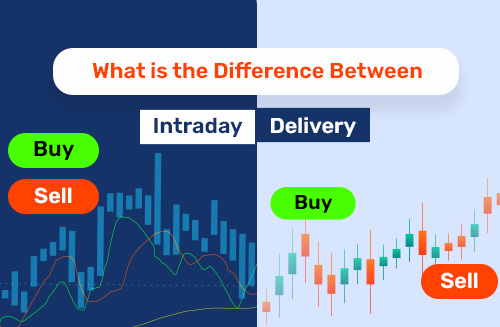Intraday trading is when you buy and sell stocks on the same day. For delivery, you can keep the stocks for a longer time. If you don’t sell your shares on the same day, it becomes a delivery trade. In intraday, both buying and selling happen on the same day, so the overall holding position is zero. Strategies for intraday and delivery trading are different, let us take the time to understand the difference between both of them and compare them step by step.
What Is Intraday Trading?
Intraday trading, also known as day trading, involves the purchase and sale of a stock within a single trading session, typically on the same day. If you don’t close your position by the day’s end, your stock may be automatically sold at the closing price, depending on your brokerage plan. Many traders start an intraday trade by setting a target price for a stock and buying it if the current price is below the target. They then sell the stock if it reaches the target price or if they believe it won’t reach the target before the market closes. The goal of intraday trading is to earn quick profits within the same day.
How Intraday Trading works
Here’s how intraday trading works:
Imagine the shares of XYZ Ltd were worth Rs 500 each at 10:15 AM. By 02:15 PM, the price went up to Rs 550 per share. Mr. Raj, who is an intraday trader, bought 1,000 shares of XYZ Ltd. for Rs 500 each in the morning. When the price reached Rs 550, he sold his shares, which totaled Rs 50,000 in just a few hours. So he made a profit of Rs 50 per share. However, it’s important to note that day traders like Mr. Raj often face high brokerage charges. These charges, including Securities Transaction Tax (STT), SEBI Regulatory Fee, Transaction Charges, Stamp Duty, and GST on brokerage, can eat up a portion of the intraday profit due to frequent buying and selling of shares.
What is Delivery Trading?
In delivery trading, the stocks you purchase are stored in your demat account and stay with you until you choose to sell them, whether it’s in a few days, weeks, months, or even years. During this time, you have full ownership of your stocks.
The Importance Of Trading Margins
A key difference between intraday and delivery-based trading lies in trading margins.
Trading margins are crucial in intraday trading, allowing you to boost earnings by borrowing from your broker. With a 10x margin, investing Rs. 10,000 means you can borrow Rs. 90,000, making a total investment of Rs. 1,00,000. While this can amplify profits, it also increases the risk of losses, emphasising the need for caution. In intraday trading, brokers may offer more margin compared to delivery-based trades, given the assurance of same-day settlement.
How Your Approach Should Differ For Intraday And Delivery Trades?
Different investors have different strategies, and it’s important to adapt your approach for intraday and delivery trades. Here are some key points to consider:
Trading Volumes:
- Intraday traders should focus on stocks with higher trading volumes, especially those of larger and well-known companies.
- Liquidity is crucial for intraday trades, and higher trading volumes make it easier to buy and sell shares quickly.
Price Levels:
- Set clear price targets and stop losses for both intraday and delivery trades, but these are particularly crucial for intraday trading.
- Intraday trades are time-sensitive, so missing an opportunity to exit at a favourable price or limit losses can be challenging.
Investment Analysis:
- Intraday trades often rely on technical indicators and event-driven strategies, anticipating short-term price movements.
- For delivery-based trading, focus on companies with strong long-term prospects. This requires a detailed analysis of their business environment and internal operations.
Tailor your strategy based on the time sensitivity and goals of each trade type. Intraday trades benefit from a focus on liquidity and quick decision-making, while delivery-based trades require a more in-depth analysis of a company’s long-term potential.
Conclusion
Investors can take advantage of BlinkX’s trading app which has zero brokerage fees by opening a trading account, allowing us to explore a variety of investment options from mutual funds to stocks, futures, options, and wealth baskets. To each his own. Intraday trading is suitable for traders who have the stomach for higher risks, losses, and timely monitoring of the market happenings. If not, it would be better to opt for delivery-based trades. The good news is you can easily convert an intraday trade into a delivery-based trade.

